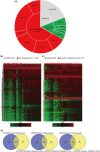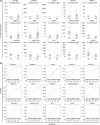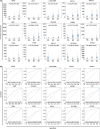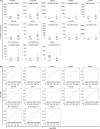Identification of seven tumor-educated platelets RNAs for cancer diagnosis
- PMID: 33955587
- PMCID: PMC8183939
- DOI: 10.1002/jcla.23791
Identification of seven tumor-educated platelets RNAs for cancer diagnosis
Abstract
Background: Tumor-educated platelets (TEPs) may enable blood-based cancer diagnosis. This study aimed to identify diagnostic TEPs genes involved in carcinogenesis.
Materials and methods: The TEPs differentially expressed genes (DEGs) between healthy samples and early/advanced cancer samples were obtained using bioinformatics. Gene ontology (GO) analysis and Kyoto encyclopedia of genes and genomes (KEGG) pathway enrichment analysis were used to identify the pathways and functional annotation of TEPs DEGs. Protein-protein interaction of these TEPs DEGs was analyzed based on the STRING database and visualized by Cytoscape software. The correlation analysis and diagnostic analysis were performed to evaluate the diagnostic value of TEPs mRNAs expression for early/advanced cancers. Quantitative real-time PCR (qRT-PCR) was applied to validate the role of DEGs in cancers.
Results: TEPs mRNAs were mostly involved in protein binding, extracellular matrix, and cellular protein metabolic process. RSL24D1 was negatively correlated to early-stage cancers compared to healthy controls and may be potentially used for early cancer diagnosis. In addition, HPSE, IFI27, LGALS3BP, CRYM, HBD, COL6A3, LAMB2, and IFITM3 showed an upward trend in the expression from early to advanced cancer stages. Moreover, ARL2, FCGR2A, and KLHDC8B were positively associated with advanced, metastatic cancers compared to healthy controls. Among the 12 selected DEGs, the expression of 7 DEGs, including RSL24D1, IFI27, CRYM, HBD, IFITM3, FCGR2A, and KLHDC8B, were verified by the qRT-PCR method.
Conclusion: This study suggests that the 7-gene TEPs liquid-biopsy biomarkers may be used for cancer diagnosis and monitoring.
Keywords: bioinformatics analysis; diagnosis; mRNA; tumor educated platelets.
© 2021 The Authors. Journal of Clinical Laboratory Analysis published by Wiley Periodicals LLC.
Conflict of interest statement
The authors declare no conflict of interest.
Figures







Similar articles
-
Identification and validation of core genes in tumor-educated platelets for human gastrointestinal tumor diagnosis using network-based transcriptomic analysis.Platelets. 2023 Dec;34(1):2212071. doi: 10.1080/09537104.2023.2212071. Platelets. 2023. PMID: 37212262
-
Identification of candidate biomarkers and pathways associated with SCLC by bioinformatics analysis.Mol Med Rep. 2018 Aug;18(2):1538-1550. doi: 10.3892/mmr.2018.9095. Epub 2018 May 29. Mol Med Rep. 2018. PMID: 29845250 Free PMC article.
-
Integrated bioinformatics analysis for differentially expressed genes and signaling pathways identification in gastric cancer.Int J Med Sci. 2021 Jan 1;18(3):792-800. doi: 10.7150/ijms.47339. eCollection 2021. Int J Med Sci. 2021. PMID: 33437215 Free PMC article.
-
Tumor-Educated Platelets in Urological Tumors: A Novel Biosource in Liquid Biopsy.Int J Mol Sci. 2025 Apr 11;26(8):3595. doi: 10.3390/ijms26083595. Int J Mol Sci. 2025. PMID: 40332071 Free PMC article. Review.
-
The use of platelets as a clinical tool in oncology: opportunities and challenges.Cancer Lett. 2024 Dec 28;607:217044. doi: 10.1016/j.canlet.2024.217044. Epub 2024 Jun 12. Cancer Lett. 2024. PMID: 38876385 Review.
Cited by
-
Multi-omics analysis of overexpressed tumor-associated proteins: gene expression, immunopeptide presentation, and antibody response in oropharyngeal squamous cell carcinoma, with a focus on cancer-testis antigens.Front Immunol. 2024 Jul 29;15:1408173. doi: 10.3389/fimmu.2024.1408173. eCollection 2024. Front Immunol. 2024. PMID: 39136024 Free PMC article.
-
Pro-Tumorigenic and Thrombotic Activities of Platelets in Lung Cancer.Int J Mol Sci. 2023 Jul 25;24(15):11927. doi: 10.3390/ijms241511927. Int J Mol Sci. 2023. PMID: 37569299 Free PMC article. Review.
-
Human pre-60S assembly factors link rRNA transcription to pre-rRNA processing.RNA. 2022 Nov 2;29(1):82-96. doi: 10.1261/rna.079149.122. Online ahead of print. RNA. 2022. PMID: 36323459 Free PMC article.
-
Liquid biopsy techniques and lung cancer: diagnosis, monitoring and evaluation.J Exp Clin Cancer Res. 2024 Apr 1;43(1):96. doi: 10.1186/s13046-024-03026-7. J Exp Clin Cancer Res. 2024. PMID: 38561776 Free PMC article. Review.
-
Platelets Purification Is a Crucial Step for Transcriptomic Analysis.Int J Mol Sci. 2022 Mar 13;23(6):3100. doi: 10.3390/ijms23063100. Int J Mol Sci. 2022. PMID: 35328521 Free PMC article.
References
-
- Siegel RL, Miller KD, Jemal A. Cancer statistics, 2020. CA Cancer J Clin. 2020;70(1):7‐30. - PubMed
-
- Vaidyanathan R, Soon RH, Zhang P, Jiang K, Lim CT. Cancer diagnosis: from tumor to liquid biopsy and beyond. Lab Chip. 2018;19(1):11‐34. - PubMed
-
- Krebs MG, Metcalf RL, Carter L, Brady G, Blackhall FH, Dive C. Molecular analysis of circulating tumour cells‐biology and biomarkers. Nat Rev Clin Oncol. 2014;11(3):129‐144. - PubMed
MeSH terms
Substances
Grants and funding
LinkOut - more resources
Full Text Sources
Other Literature Sources
Medical
Miscellaneous

